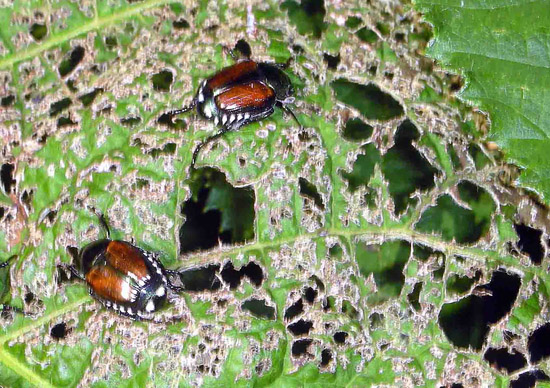Issue 8, June 23, 2014
Japanese Beetle
Japanese beetle adults are present throughout Illinois. Robert Bellm, Extension Educator, reported their presence in Madison County, and Ed Nangle, Chicago District Golf Association, reported their presence in Cook County. Last week in this newsletter, we predicted low numbers in the northern half of the state due to the extended deep soil freezing last winter. The drought in the second half of last summer should cause reductions in their numbers throughout the state in areas where there was little turf irrigation. If Japanese beetle adult numbers appear to be low in your area, less preferred ornamental plant species may not need to be sprayed or sprayed as many times.
Adult Japanese beetles feed on the upper leaves of crabapple, linden, serviceberry, flowering cherry, birch, willow, rose, and many other trees and shrubs from late June through mid-August. They can defoliate or window-feed at least the upper third of the tree. Window-feeding consists of eating the upper surface and center of the leaf, leaving the lower surface which is whitish and somewhat transparent. The cells of this exposed lower surface soon turn brown. The adult Japanese beetles are three-eighths to one-half inch long and stocky with metallic green bodies and coppery wing covers.

Damage from adult Japanese beetles.
Imidacloprid, sold as Merit and other brand names, moves systemically through the tree into the leaves where it effectively controls the adult beetles. Imidacloprid takes just a couple of days to move into the leaves whether trunk injected or soil applied. Avoid application of imidacloprid into mulch, thatch, or other dead organic matter as the insecticide adsorbs onto it, making it unavailable for root uptake. Soil inject below the sod or mulch or pull back the sod or mulch to soil drench. Apply within two feet of the trunk.
Imidacloprid remains in the tree for at least a year after application, so application at any time during the growing season is effective as long as there are active leaves on the trees. The active leaves are needed to drive the transpiration which moves the imidacloprid throughout the tree.
There is concern about imidacloprid moving into the pollen and nectar of flowers and affecting honey bees and other pollinators. Imidacloprid is known to move into linden flowers, so its use on that tree should be avoided. Wind-pollinated trees, such as birches, are unlikely to be visited by pollinators. Roses with double blossoms are usually not visited by pollinators either, but watch for flower visits by bees or other pollinators before applying imidacloprid. Imidacloprid does not move into crabapple flowers. Realize that soil applications will move into flowers grown near the tree as well as nearby dandelions and other flowering weeds visited by pollinators.
Spraying the foliage with a labeled pyrethroid avoids most pollinator concerns. Although fresh residues are toxic to honey bees and other pollinators, pyrethroids will kill the visiting bee too quickly to carry anything back to the hive. Insecticides carried back to the hive to affect larvae and other colony members is the biggest concern with imidacloprid and other neonicotinoid insecticides. Carbaryl, sold as Sevin, can be applied to non-flowering trees and shrubs. Although honey bees will actively gather the dried carbaryl residue and take it back to the hive, they are unlikely to discover it on a non-flowering plant. Pyrethroid or carbaryl sprays should be repeated every couple of weeks to maintain protection. With the Japanese beetle adults present in large numbers for about six weeks, three sprays are typically needed. (Phil Nixon)
Author:
Phil Nixon